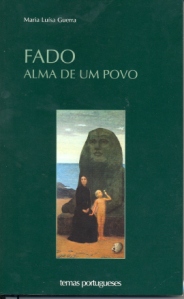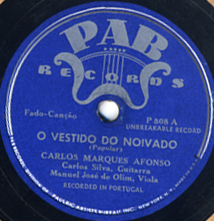 Instrumentally, fado is distinguished by the use of the guitarra portuguesa, a pear-shaped lute- or cittern-like instrument with twelve steel strings (tuned DDAABBEEAABB, from low to high, in the Lisbon style to which I mostly refer). The guitarra is played via a combination of strumming and plucking, using mostly the thumb and index finger, on which are worn unhas (‘nails’). Although in the past the guitarra had provided only harmony, by the period covered in Fado and the Place of Longing it had taken a more dominant role as provider of the melody in instrumental numbers or melodic counterpart to the voice in songs. The other constant accompaniment is provided by the viola (Spanish guitar), which provides harmony and rhythm predominantly but may occasionally lead. In addition, especially in contemporary practice, a viola baixo (acoustic bass guitar) is often added. Additional percussion is rarely used.
Instrumentally, fado is distinguished by the use of the guitarra portuguesa, a pear-shaped lute- or cittern-like instrument with twelve steel strings (tuned DDAABBEEAABB, from low to high, in the Lisbon style to which I mostly refer). The guitarra is played via a combination of strumming and plucking, using mostly the thumb and index finger, on which are worn unhas (‘nails’). Although in the past the guitarra had provided only harmony, by the period covered in Fado and the Place of Longing it had taken a more dominant role as provider of the melody in instrumental numbers or melodic counterpart to the voice in songs. The other constant accompaniment is provided by the viola (Spanish guitar), which provides harmony and rhythm predominantly but may occasionally lead. In addition, especially in contemporary practice, a viola baixo (acoustic bass guitar) is often added. Additional percussion is rarely used.
 The fado singer, or fadista, tends to take the centre stage in a performance of gesture, phrasing and verbal improvisation that serves to heighten the drama of the lyric and lead the song to an appropriately momentous conclusion. Drama is often emphasized by alternating between registers and songs invariably close on a vocal climax that repeats the last part of the final verse or chorus and is punctuated by a two-chord full stop, or exclamation mark, from the guitars (generally, V–I). Lyrics are of vital importance in fado and, while some are improvised (especially in amateur settings), most are the work of fado lyricists who are not normally involved in the performing group. Adaptations of so-called ‘erudite poetry’ are common and mix with more down to earth variations of a range of lyrical themes.
The fado singer, or fadista, tends to take the centre stage in a performance of gesture, phrasing and verbal improvisation that serves to heighten the drama of the lyric and lead the song to an appropriately momentous conclusion. Drama is often emphasized by alternating between registers and songs invariably close on a vocal climax that repeats the last part of the final verse or chorus and is punctuated by a two-chord full stop, or exclamation mark, from the guitars (generally, V–I). Lyrics are of vital importance in fado and, while some are improvised (especially in amateur settings), most are the work of fado lyricists who are not normally involved in the performing group. Adaptations of so-called ‘erudite poetry’ are common and mix with more down to earth variations of a range of lyrical themes.
Stylistically, Lisbon fado can generally be divided into fado castiço (‘authentic fado’, also known as fado fado, fado clássico and fado tradicional) and fado canção (‘song fado’). Fado castiço styles were concretized in the mid-late eighteenth century and include fado corrido (‘running fado’), fado mouraria (named after the Lisbon district discussed earlier) and fado menor (‘minor fado’) and numerous variations of these three basic styles often named after particular guitarists and composers. Salwa Castelo-Branco provides a useful and concise description of the castiço styles:
All three fados have fixed rhythmic and harmonic schemes (I–V) and a fixed accompaniment pattern consisting of a melodic motif that is constantly repeated, at times with slight variation. Using these patterns as a basis, the melody is either composed or improvised. Texts are usually set to one of the most common poetic structures, such as the quatrain or five-, six- and ten-verse stanzas. The accompaniment pattern, the I–V harmonic scheme and the regular 4/4 metre are the identifying elements of these fados and are basically fixed. All other elements are variable. Fado corrido and mouraria, in the major mode, are usually performed in a fast tempo and have similar accompaniment patterns. Fado menor is in the minor mode and is often performed in a slow tempo.
(Salwa El-Shawan Castelo-Branco, ‘Fado’, in L. Macy (ed.), Grove Music Online, http://www.grovemusic.com.)
.
Fado canção was a development of the late nineteenth century and evolved through theatrical revistas (shows). It is distinguished by a stanza- and refrain-based song style and uses more complex harmonic structures. It is this style that came to be associated with Amália Rodrigues and those influenced by her, although both Amália and the ‘new fadistas’ continued to perform the more traditional styles.
Three classic examples of the castiço styles that can be fairly easily sourced are:
Lucília do Carmo, ‘Maria Madalena’ (fado mouraria)
Carlos do Carmo, ‘Por Morrer uma Andorinha’ (fado menor)
Maria Teresa de Noronha, ‘Corrido em Cinco Estilos’ (fado corrido)
Miguel Baptista has posted videos of the basic guitarra styles on YouTube.
Classic examples of fado canção include Alfredo Marceneiro’s ‘Há Festa na Mouraria‘ and Amália Rodrigues’s ‘Gaivota’.




